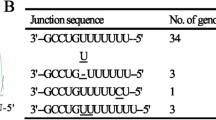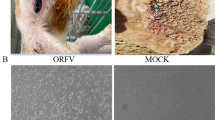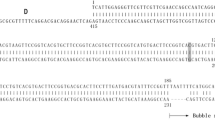Abstract
RD-114 virus is a replication-competent feline endogenous retrovirus. RD-114 virus contaminates several feline and canine live attenuated vaccines and the issue of contamination of RD-114 virus in vaccines should be solved. To date, three infectious molecular clones (pSc3c, pCRT1, and pRD-UCL) have been reported. In this study, we sequenced the entire nucleotide sequence of pRD-UCL and compared the nucleotide sequences of the three infectious molecular clones. As a result, these three infectious clones were nearly identical with each other in gag-pol and env coding regions. These data support the notion that the active locus of infectious RD-114 virus is single in the feline genome. The length of long terminal repeat (LTR) of pCRT1 was 47 bp shorter than those of pSc3c and pRD-UCL. The 47-bp sequence named direct repeat A (DR-A) was duplicated in the U3 region in pSc3c and pRD-UCL. Although several potential enhancer binding sites are present in the DR-A, there was no significant difference in promoter activities between the LTRs of pRD-UCL and pCRT1 in two human cell lines. We also analyzed the splicing pattern of the RD-114 virus by reverse transcription-polymerase chain reaction and confirmed that RD-114 virus is a simple retrovirus. The data presented here will provide basic information about RD-114 virus to solve the contamination issue in live attenuated vaccines.




Similar content being viewed by others
References
R.H. Reeves, S.J. O’Brien, J. Virol. 52, 164–171 (1984)
R.H. Reeves, W.G. Nash, S.J. O’Brien, J. Virol. 56, 303–306 (1985)
T. Miyazawa, Biologicals 38, 371–376 (2010)
T. Miyazawa, R. Yoshikawa, M. Golder, M. Okada, H. Stewart, M. Palmarini, J. Virol. 84, 3690–3694 (2010)
R. Yoshikawa, E. Sato, T. Igarashi, T. Miyazawa, J. Clin. Microbiol. 48, 3366–3369 (2010)
R. Narushima, T. Shimazaki, T. Takahashi, Biologicals 39, 89–93 (2011)
R. Yoshikawa, J. Yasuda, T. Kobayashi, T. Miyazawa, J. Gen. Virol. 93, 603–607 (2012)
A.C. Van der Kuyl, J.T. Dekker, J. Goudsmit, J. Virol. 73, 7994–8002 (1999)
R.M. McAllister, M. Nicolson, M.B. Gardner, R.W. Rongey, S. Rasheed, P.S. Sarma, R.J. Huebner, M. Hatanaka, S. Oroszlan, R.V. Gilden, A. Kabigting, L. Vernon, Nat. New Biol. 235, 3–6 (1972)
S. Sakaguchi, M. Okada, T. Shojima, K. Baba, T. Miyazawa, J. Vet. Med. Sci. 70, 785–790 (2008)
S. Sakaguchi, K. Baba, M. Ishikawa, R. Yoshikawa, T. Shojima, T. Miyazawa, J. Vet. Med. Sci. 70, 1383–1386 (2008)
M. Okada, R. Yoshikawa, T. Shojima, K. Baba, T. Miyazawa, Virus Res. 155, 268–273 (2011)
Y. Takeuchi, F.-L. Cosset, P.J. Lachmann, H. Okada, R.A. Weiss, M.K. Collins, J. Virol. 68, 8001–8007 (1994)
A. Fukuma, M. Abe, S. Urata, R. Yoshikawa, Y. Morikawa, T. Miyazawa, J. Yasuda, Virol. J. 8, 540 (2011)
F.-L. Cosset, Y. Takeuchi, J.-L. Battini, R.A. Weiss, M.K.L. Collins, J. Virol. 69, 7430–7436 (1995)
Y. Takeuchi, C. Patience, S. Magre, R.A. Weiss, P.T. Banerjee, P. Le Tissier, J.P. Stoye, J. Virol. 72, 9986–9991 (1998)
K. Ghani, S. Cottin, P.O. de Campos-Lima, M.C. Caron, M. Caruso, J. Gene Med. 11, 664–669 (2009)
D.A. Spodick, A.K. Ghosh, S. Parimoo, P. Roy-Burman, Virus Res. 9, 263–283 (1988)
T. Heinemeyer, E. Wingender, I. Reuter, H. Hermjakob, A.E. Kel, O.V. Kel, E.V. Ignatieva, E.A. Ananko, O.A. Podkolodnaya, F.A. Kolpakov, N.L. Podkolodny, N.A. Kolchanov, Nucleic Acids Res. 26, 362–367 (1998)
S. Kharytonchyk, F.S. Pedersen, RNA 16, 572–584 (2010)
M.D. Papenhausen, J. Overbaugh, Virology 195, 804–807 (1993)
Acknowledgments
We are grateful to Dr. Yasuhiro Takeuchi (University College London, London, UK) for providing TELCeB6/pRDF cells, TE671 cells, TE671 cells chronically infected with RD-114 virus. We thank Dr. Roger Reeves (Johns Hopkins University, Baltimore, MD, USA) for providing pSc3c. This work was supported by a grant-in-aid from the Bio-oriented Technology Research Advancement Institution of Japan.
Author information
Authors and Affiliations
Corresponding author
Additional information
Sayumi Shimode and Rokusuke Yoshikawa have contributed equally to this study.
Rights and permissions
About this article
Cite this article
Shimode, S., Yoshikawa, R., Hoshino, S. et al. Sequence comparison of three infectious molecular clones of RD-114 virus. Virus Genes 45, 393–397 (2012). https://doi.org/10.1007/s11262-012-0759-0
Received:
Accepted:
Published:
Issue Date:
DOI: https://doi.org/10.1007/s11262-012-0759-0




